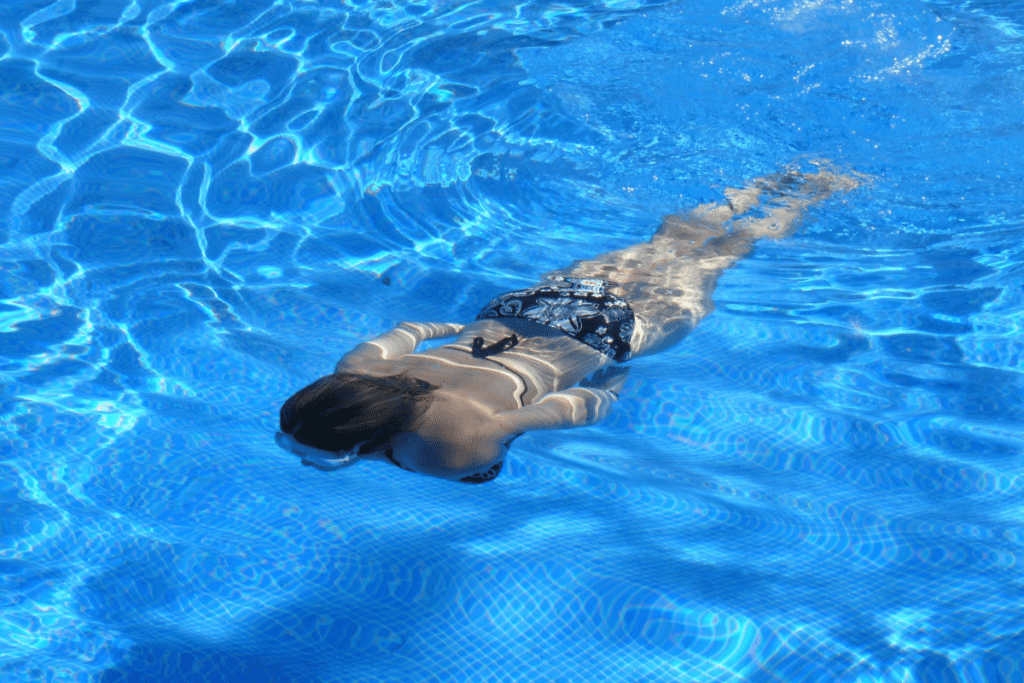A Guide to Swimming for Beginners
If you told me a year ago that I would be swimming three times per week with a goal to swim in Chicago’s Sprint Triathlon, I would’ve laughed out loud and continued my land-based training. Yet, here I am every Friday afternoon, next to two kids taking swimming lessons, hoping they don’t show me up with their freestyle strokes.
I’ve been swimming for the past three months, and I know it will remain as part of my exercise routine. But honestly, it took support and tools to get to this place. Interested in dipping your toe in the lap pool waters? Here’s what I’ve learned this summer in a guide to beginner swimming.

Why learn to swim?
As with all things in life, it’s valuable to know your purpose in choosing to start swimming. There are numerous reasons for why swimming is an excellent form of exercise. According to Better Health, one benefit of swimming is that it raises your heart rate without having impact on your joints. For those who have sore joints or a history of injury, swimming can allow for full-body fitness without pain.
Additionally, the benefits of swimming extend beyond physical health. According to Just Swim, swimming has been connected to a reduction in symptoms of anxiety or depression. This is likely due to swimming being a series of steady strokes and breathing, which makes it a mindful practice.
Finally, another benefit of swimming is that one can begin swimming at any age. When I started swimming, I saw this article in the New York Times, which describes a woman named Vijaya Srivastava who started swimming at 68. She has since made it a regular part of her routine and is an inspiration.
What gear do you need to start swimming?
One of the most important parts of beginner swimming is having the appropriate gear. My first time swimming a lap in a pool, my suit hadn’t yet come in the mail—so I swam in a sports bra and bikini bottoms. Though this allowed me to “get the job done,” I was much better suited to swim when I wore appropriate attire.
But swim gear isn’t limited to a suit and goggles. Below are some items that beginner swimmers may want to add to their tool box.
Proper swimsuit
Having a proper suit for swimming can make a huge difference. A swimsuit for lap swimming should feel compact and glide through the water to ease your swimming experience. According to YourSwimBook, here are the 13 best training and lap swimming suits for men and the 7 best training and lap swimming suits for women.
Goggles
Another essential piece of gear for swimming is goggles. There are different types of goggles, but the main difference is that some goggles are meant for indoor pools and some are meant for outdoor pools and lakes, which are typically tinted to account for sun glare. Here, Swim Competitive has a compiled list of some of the best goggles for beginners at varying price points.
Cap
Another tool for swimming is having a proper cap. Swim caps are useful for many reasons. They keep your hair away from your face and the pool, which helps you see more clearly, minimize drag, and maintain pool cleanliness. Additionally, swim caps allow for protection of your hair from the impacts of chlorine. Very Well Fit provides a list of 12 swim caps based on the swimmers needs, including finances, competition level, and hair length and texture.
Swim fins
Swim fins are a useful tool for swimmers as they improve form and increase speed. Typically, short fins are recommended for beginners as they build leg strength, flexibility, and kick technique. Here, Sportlia provides a review of a variety of swim fins.
Hand paddles
Similar to swim fins, hand paddles are useful for beginning swimmers as they support in building upper body strength, improving technique, and adding variety to a swim workout. Athlete Approved provides their rankings of various swim paddles here.
Pull buoy
Pull buoys are essential tools when learning how to improve swimming form. A common ailment of swimmers of all abilities is “sinking legs.” Sinking legs occurs when the legs and feet of a swimmer float beneath their upper body and create drag. Pull buoys are used to help swimmers feel the appropriate positioning of their body in the water. More information about pull-buoys and how to purchase them are provided here.
Kick board
Kick boards are used, simply, to improve your swimming kick. They allow the swimmer to focus on their kick primarily and practice proper body positioning. Different types of kick boards and their purposes are outlined here.
Beginner swimming: Getting started
Now that you have your “why” and know what gear is needed to start swimming, the last, but perhaps scariest piece of the puzzle is getting started.
My first recommendation is to see if there is a local pool that offers adult beginner swimming lessons. Having a professional guide you can allow for an increased sense of safety and hands-on support for improvement. Adult swimming lessons are often offered in groups or individually.
My triathlon coach, Kristan Huenink, recommends getting into the pool more frequently for shorter spurts of time than few longer workouts. This is because swimming well is dependent on technique. When swimming longer, we get tired, and are less able to focus on form. It can be useful to watch YouTube videos to have good visualization of proper form. Additionally, if someone is able, it can be helpful to have videotape of your swimming so you can identify your own swimming needs.
All of this aside, the most important part of beginner swimming is jumping into a pool and being open to learning a new skill.












